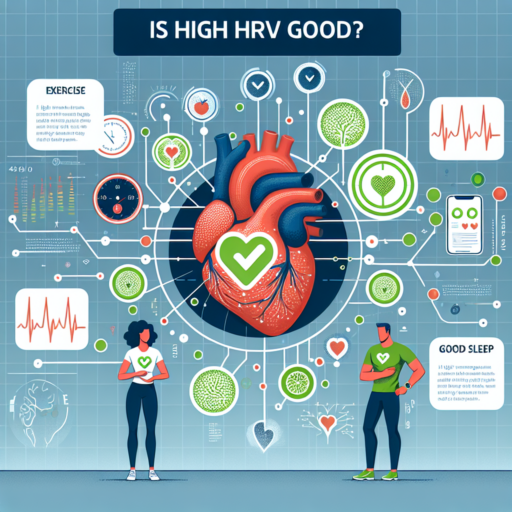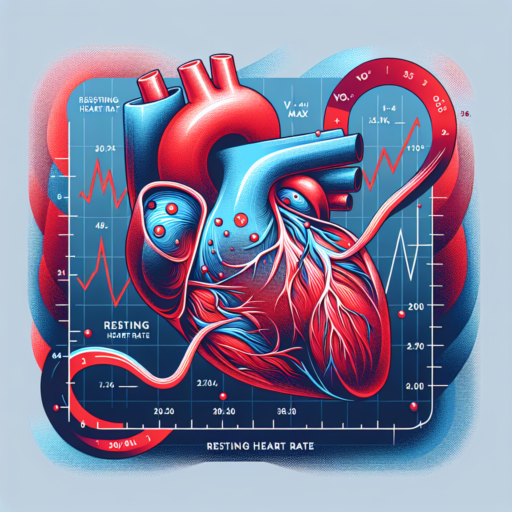No se han encontrado productos.
Understanding HRV: What Does It Mean for Your Health?
Heart Rate Variability (HRV) is becoming an increasingly popular metric for assessing physical fitness, stress levels, and overall well-being. But what exactly is HRV, and why is it important for your health? Essentially, HRV measures the variation in time between each heartbeat, which is directly linked to your autonomic nervous system (ANS). This system controls your fight or flight response, and HRV serves as a window into its balance and functioning. Understanding your HRV can provide valuable insights into your body’s ability to manage stress, recover from exercise, and maintain overall health.
HRV and Stress Management: One of the key benefits of monitoring HRV is its ability to indicate stress levels. A higher HRV suggests a better ability to adapt to stress, while a lower HRV points to a potentially overstressed system. This information can be crucial for developing strategies for stress management and improving your mental and physical health. By tracking HRV, individuals can identify patterns or activities that significantly impact their stress levels and take proactive steps to mitigate these factors.
HRV as a Predictor of Physical Fitness
Interestingly, HRV is not just about stress and relaxation. It’s also a powerful predictor of physical fitness and performance. Athletes and fitness enthusiasts may use HRV measurements to gauge their recovery status and readiness for training, ensuring they do not overtrain and risk injury or burnout. This capability makes HRV a valuable tool for optimizing your exercise routine and improving your physical health.
Is High HRV Good? Unraveling the Metrics Behind Heart Rate Variability
Understanding the significance of Heart Rate Variability (HRV) is crucial for anyone looking to gauge their overall health and fitness levels. HRV measures the time variation between each heartbeat, indicating the heart’s ability to respond to different stress levels, environments, and stimuli. A common question that emerges among fitness enthusiasts and health-conscious individuals is: Is a high HRV indicative of positive health outcomes?
In terms of physical fitness and wellness, a higher HRV is often associated with a greater ability of the heart to adapt to stress, exercise, and even relaxation phases. Individuals with a higher HRV typically possess a more resilient cardiovascular system, enabling them to recover more efficiently after physical exertion. It reflects a balanced autonomic nervous system and, by extension, a state of good health and reduced stress levels.
However, interpreting HRV metrics accurately demands an understanding of personal baseline measurements. HRV is highly individualistic, and what may be considered a ‘high’ value for one person could be completely normal for another. This variability underscores the importance of monitoring HRV over time to identify personal trends and understand how lifestyle modifications can impact overall health.
The Benefits of Having a High HRV: A Deep Dive into Cardiovascular Health
Understanding and maintaining a high Heart Rate Variability (HRV) is emerging as a critical factor in enhancing overall cardiovascular health. High HRV is indicative of a robust and responsive cardiovascular system, capable of adapting to stressors and demands efficiently. This deep dive into the benefits associated with high HRV will elucidate its significance in promoting heart health and overall well-being.
The Indicator of Autonomic Nervous System Balance
At its core, a high HRV represents a balanced Autonomic Nervous System (ANS), which controls the body’s involuntary functions, including heart rate. The ANS is divided into the sympathetic and parasympathetic nervous systems. A high HRV signifies a healthy balance between these two systems, indicating flexibility and resilience in physiological responses. This balance ensures that the body can efficiently switch between rest and activity states, highlighting a key pillar of cardiovascular fitness.
Enhanced Stress Resilience
One of the most compelling benefits of a high HRV is its correlation with improved stress resilience. Stress, particularly when chronic, exerts significant wear and tear on the cardiovascular system. High HRV signifies a body’s better ability to cope with stress, reducing the potential negative impact on the heart. This enhanced resilience supports not only cardiovascular health but also contributes to overall mental well-being, marking a critical intersection between psychological health and heart function.
In summary, the benefits of maintaining a high HRV extend beyond mere cardiovascular efficiency. It encompasses a broader spectrum involving autonomic nervous system balance, stress resilience, and an integrated approach to wellness. As research in this field continues to evolve, the importance of HRV as a key marker of heart health and general well-being becomes increasingly clear.
How to Interpret Your HRV Scores for Optimal Health and Fitness
Understanding your Heart Rate Variability (HRV) scores is crucial in gauging your overall health and fitness levels. HRV measures the variations in time between each heartbeat, which is directly linked to your autonomic nervous system’s (ANS) performance. A higher HRV indicates a robust and responsive ANS, capable of efficiently managing stress, recovery, and overall well-being.
Identify Your Baseline HRV
To accurately interpret your HRV scores, first establish your baseline. This involves monitoring your HRV over a period—preferably a few weeks—under similar conditions, like time of day and mental state, to get consistent readings. Your baseline HRV is unique to you and serves as a point of reference. Fluctuations from this baseline can then be assessed to understand how various factors, such as stress, sleep quality, and physical exertion, impact your health and recovery status.
Understand HRV Trends Over Time
Rather than fixating on daily changes, focus on long-term trends in your HRV scores. Gradual increases in your baseline HRV over time suggest improvements in fitness levels and autonomic nervous system resilience, indicating effective stress management and recovery capabilities. Conversely, a consistent downward trend could signal overtraining, inadequate recovery, or emerging health issues. It’s essential to pay attention to these trends and adjust your lifestyle, exercise, and recovery practices accordingly.
Monitoring and interpreting your HRV scores can function as a powerful tool in optimizing your health and fitness strategy. By understanding the significance of your baseline HRV and its long-term trends, you can make informed decisions about your training intensity, rest days, and stress management techniques. Keep in mind, an individualized approach is key—as everyone’s body responds differently to stress and recovery stimuli.
Improving Your HRV: Lifestyle Changes That Can Boost Heart Rate Variability
Improving your Heart Rate Variability, or HRV, can significantly influence your overall well-being and athletic performance. HRV refers to the variation in time between each heartbeat, which is considered a marker of your body’s ability to adapt to stress and maintain balance. Lifestyle changes are pivotal in enhancing your HRV, offering a non-invasive way to potentially boost your health and resilience.
Engage in Regular Physical Activity
One of the most effective methods to improve your HRV is through consistent physical exercise. Activities such as walking, cycling, and swimming not only strengthen your heart muscle but also enhance its efficiency in variability. It’s crucial, however, to balance intensity; while moderate exercise can uplift your HRV, excessive high-intensity workouts may lead to the opposite effect.
Practice Mindfulness and Stress Reduction Techniques
Mental and emotional health plays a significant role in influencing HRV. Adopting stress reduction techniques such as mindfulness, yoga, or deep breathing exercises can aid in calming the mind and body, thereby improving heart rate variability. These practices help in reducing stress and anxiety levels, which are known to negatively impact HRV.
High HRV and Athletic Performance: What Athletes Should Know
The correlation between High Heart Rate Variability (HRV) and athletic performance is a pivotal area of interest for athletes at all levels. Understanding the significance of HRV can empower individuals to optimize their training and recovery processes, leading to enhanced performance outcomes. Essentially, a higher HRV indicates a more adaptable cardiovascular system, which is beneficial for athletes seeking to maximize their physical potential.
HRV serves as a critical indicator of autonomic nervous system (ANS) balance, reflecting the body’s ability to efficiently manage stress, fatigue, and recovery. Athletes with a high HRV are generally more resilient to stress and have a faster recovery rate, enabling more intense and frequent training sessions. This resilience is crucial in competitive sports, where physical and mental stressors are at their peak, and the margin for error is minimal.
Fostering a High HRV for Athletic Advantage
To reap the benefits of high HRV, athletes must focus on strategies that enhance their autonomic balance. Incorporating ample rest, quality sleep, proper nutrition, and stress management techniques into their routine can significantly improve HRV scores. Additionally, tailored training programs that include both high-intensity and low-intensity workouts contribute to a dynamic and responsive cardiovascular system, further boosting HRV levels.
In summary, the importance of high HRV in elevating athletic performance cannot be overstated. It not only signifies a well-adapted body capable of handling rigorous training demands but also underscores the need for a holistic approach to athlete health and well-being. By prioritizing practices that support autonomic balance, athletes can unlock their true performance potential, distinguishing themselves in the competitive arena.
The Relationship Between High HRV, Stress, and Recovery Time
Exploring the intricate link between high Heart Rate Variability (HRV), stress, and recovery time unveils significant insights into our body’s resilience and adaptability. High HRV is often heralded as an indicator of good heart health and autonomic nervous system balance, implicating a robust capacity for stress management and faster recovery. This connection highlights not just the complexity of our physiological responses but also the potential for enhancing our well-being through understanding and monitoring our HRV.
The Impact of Stress on HRV
Stress, a ubiquitous aspect of modern life, manifests through various physiological responses, one of which is its effect on HRV. Chronic stress tends to lower HRV, pointing to a strained autonomic nervous system and a reduced ability to cope with stress. Conversely, high HRV is indicative of a resilient system, capable of efficiently navigating the challenges and demands of stressors. This reciprocal relationship underscores the significance of managing stress to maintain or improve HRV, thereby optimizing our body’s recovery processes.
HRV as a Marker for Recovery Time
The linkage between high HRV and expedited recovery time is grounded in the body’s dynamic ability to return to baseline after stress exposure. A higher HRV suggests a more agile and flexible response system, enabling quicker recuperation from both physical and psychological stressors. This not only contributes to enhanced performance and health over time but also serves as a critical metric for individuals looking to optimize recovery and improve stress resilience.
Measuring Your HRV: Tools and Technologies for Accurate Monitoring
Heart Rate Variability (HRV) is a critical health metric that provides insights into the autonomic nervous system and overall well-being. As interest in personal health monitoring grows, so does the variety of tools and technologies available for measuring HRV accurately. Understanding the differences and capabilities of these tools is key to achieving reliable and personalized health tracking.
Selecting the Right HRV Monitoring Device
Among the multitude of options, wearable tech—such as fitness trackers and smartwatches—stands out for its convenience and continuous monitoring abilities. Apple Watch and Fitbit are leaders in integrating comprehensive HRV tracking functionalities into their devices. For those seeking more detailed data, dedicated HRV sensors and chest straps offer a higher level of accuracy. Brands like Polar and Garmin provide specialized tools that cater specifically to athletes and health enthusiasts alike, focusing on precision and depth of data.
Understanding HRV Measurement Techniques
The science behind HRV measurement is complex, involving sophisticated algorithms to analyze the time variation between heartbeats. There are two primary methods used: time-domain analysis and frequency-domain analysis. Time-domain analysis is more straightforward, making it a common choice for consumer-grade devices. On the other hand, frequency-domain analysis offers a deeper dive into the autonomic nervous system functions but requires more advanced technology, often seen in medical-grade equipment.
Thanks to advancements in technology, home-based monitoring of HRV has become more accessible. The availability of smartphone apps that integrate with wearable devices has played a significant role in this. These apps not only track your HRV but also provide analytics and insights to help you understand your heart health better. They encourage proactive monitoring and wellness by simplifying the complexities of HRV data into actionable advice.
Common Misconceptions About High HRV: Separating Fact from Fiction
When discussing heart rate variability (HRV), it’s essential to navigate the sea of misinformation and myths that often surround it. A high HRV is generally recognized as a marker of good health and cardiovascular fitness. However, several misconceptions about what it signifies and its importance have become widespread. By separating fact from fiction, individuals can better understand the significance of HRV in their wellness journey.
One common misconception is that a high HRV is beneficial for everyone, regardless of their health condition or lifestyle. This notion simplifies the complexity of HRV and overlooks individual health contexts. It’s imperative to consider that while high HRV is often a sign of a well-functioning autonomic nervous system, it might not always reflect optimal health in certain medical conditions or scenarios.
Another widespread belief is that significant improvements in HRV can be achieved quickly through short-term interventions. This idea often leads to unrealistic expectations regarding the impact of lifestyle changes or specific health interventions on HRV. Enhancing HRV typically requires sustained, long-term efforts tailored to an individual’s unique health profile and needs.




